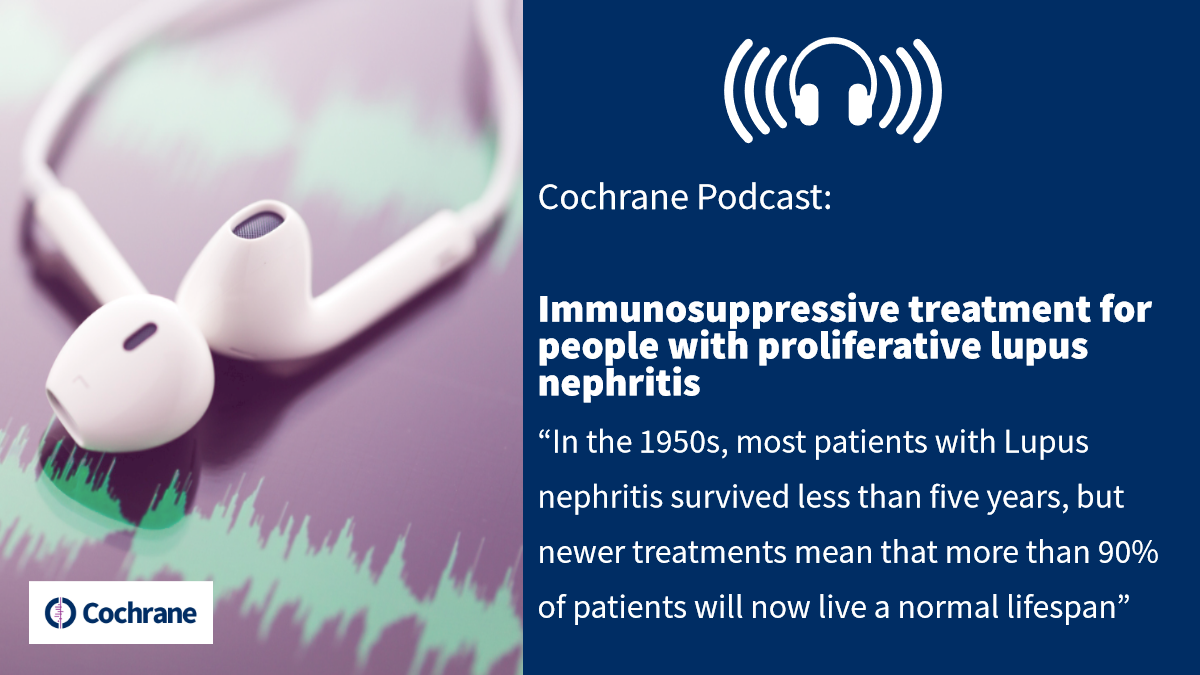
Systemic lupus erythematosus, or SLE, is an autoimmune disease that can affect any part of the body. About half the people with it develop lupus nephritis. In the June 2018 update of their Cochrane Review, David Tunnicliffe from the Centre for Kidney Research in the Children’s Hospital at Westmead and the University of Sydney’s School of Public Health in Australia and colleagues brought together the studies that have tested a range of treatments.
"Lupus nephritis is a serious condition, leading to end-stage kidney disease in 15% of patients after 10 years. It mainly affects women of child-bearing age, and is more common in some groups, such as those of Hispanic and Asian ethnicity, who also experience more aggressive disease. In the 1950s, most patients survived less than five years, but newer treatments mean that more than 90% of patients will now live a normal lifespan. Cyclophosphamide-containing regimens became established as first line therapy for inducing remission in the 1970s and 1980s, but the drug has a high incidence of adverse events, such as serious infection, hair-loss, and infertility. Furthermore, response to treatment is often slow, and even if remission is achieved, the risk or relapse or flare remains considerable.
In the past ten years, mycophenolate mofetil (MMF) emerged as a less toxic alternative to cyclophosphamide but there is uncertainty about which agent is more effectie. Over recent years, randomized trials have been done to compare these drugs and to test other therapies such as the combination of low-dose MMF and tacrolimus and newer biologic agents.
Our updated Cochrane Review evaluates the relative effects of these various drugs, looking at all available trials of immunosuppressive therapies for the induction and maintenance treatment of proliferative lupus nephritis, the most serious form of the disease.
We have now identified 74 randomized trials, involving more than 5000 participants but these trials differ in many ways and only relatively small numbers are available for the various comparisons.

For the induction of disease, eight trials, with a total of about 800 patients, compared MMF with intravenous cyclophosphamide and two trials, with 402 patients, compared low dose MMF and tacrolimus against intravenous cyclophosphamide. Our analyses show that patients receiving short term treatment of up to six months with MMF or intravenous cyclophosphamide may have similar rates of complete remission. There was less leucopenia and alopecia with MMF, but an increased risk of diarrhoea. The addition of data from some recent trials shows that the effect on ovarian failure is unclear, because of the fragility in the effect estimates. This contrasts with the general medical consensus and observational data suggesting a risk of ovarian failure from repeated cyclophosphamide doses. When tacrolimus and low-dose MMF are used together, this may increase complete remission, but the safety of this therapy is uncertain, and the generalizability of these findings is unclear because they come from just two trials, both done in China.
There are only a small number of trials evaluating the safety and efficacy of biological therapy in patients with lupus nephritis. For example, four trials, including 452 patients, have compared MMF with azathioprine for maintenance therapy and these showed a significantly lower risk of renal relapse with MMF than with azathioprine.
The best duration of therapy remains unclear and longer-term outcome data are sparse, with patients followed up for an average of 12 months in the induction therapy trials and 30 months for maintenance therapy. This is not long enough to examine critical and important outcomes, such as death and end-stage kidney disease. So, the power of the existing studies to detect significant differences among interventions is limited, even when their findings are combined in meta-analyses.
In summary, the main messages from this review are that there are similar effects for induction of remission with MMF and cyclophosphamide, but with fewer toxic effects for MMF. This supports MMF over cyclophosphamide as induction therapy for lupus nephritis. Combining low-dose MMF with tacrolimus may increase complete remission but we are cautious about this because the findings comes from few trials, restricted to patients of Asian ethnicity. Despite the small amount of data on maintenance therapy, MMF appears more effective than azathioprine at preventing renal relapse with less leucopenia and doubling of serum creatinine.
However, in conclusion, despite identifying 74 trials for our review, there are still lots of unanswered questions about the treatment of lupus nephritis. Many interventions, including rituximab and other biologics, and tacrolimus and cyclosporin, have only been tested in small studies with inconsistent outcome reporting and we see two main implications for future research: the need to make better use of existing data, and to plan new studies in a strategic way. Multi-centre collaboration and trials of longer follow-up and in a wider range of ethnic groups are needed. This research would also benefit from registry-based randomized studies, which use efficient data linkage between hospital records, and national registries, to clarify the potential benefits and harms of therapies for this uncommon disease.”
